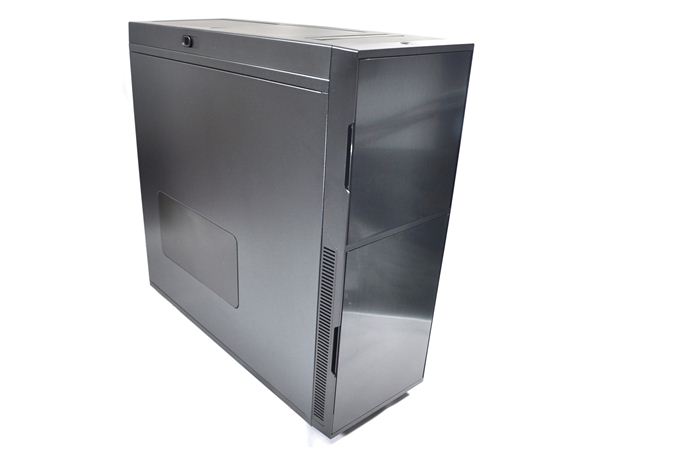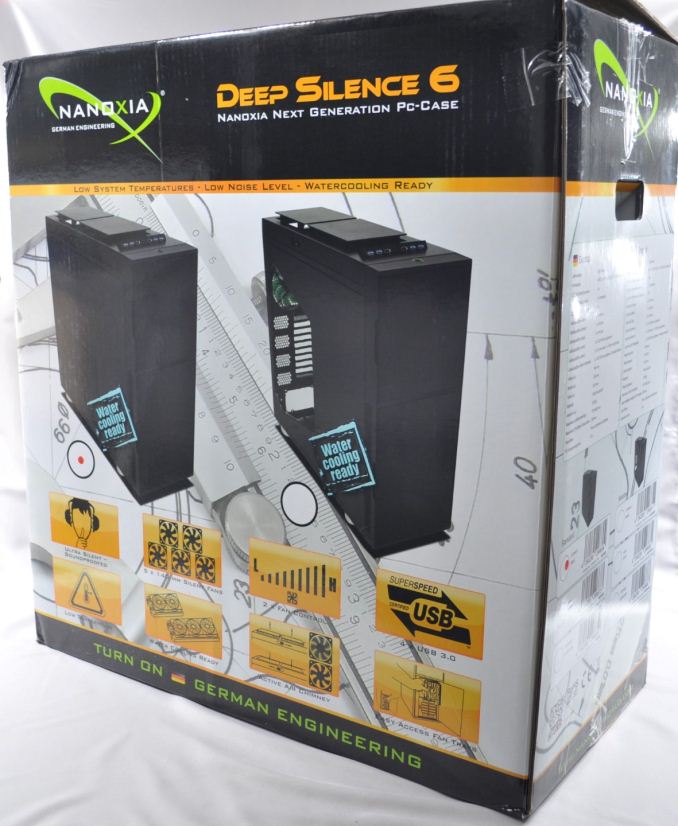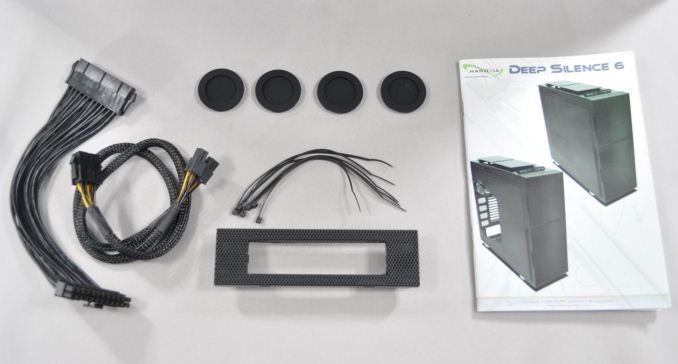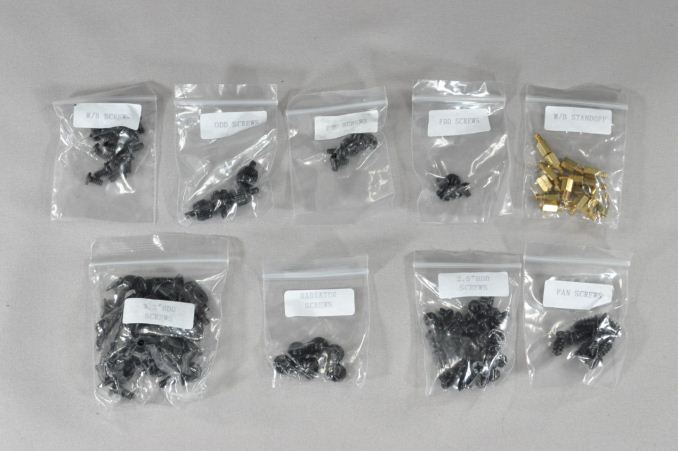Nanoxia Deep Silence 6 Review
by E. Fylladitakis on February 13, 2014 3:00 PM EST- Posted in
- Cases/Cooling/PSUs
- Full-Tower
- HPTX
- Nanoxia
- Case

Nanoxia is a German manufacturer of high performance PC cases, and they're already well known amongst enthusiasts despite the fact that the company isn't even two years old. Since our review of their first product a year ago, the Deep Silence 1, the company has come a long way. They've released six cases and are slowly taking steps towards diversifying into other market segments. Nanoxia has also released multiple case accessories and four different cooling fans series. Unfortunately, the availability of their products in the US market remains sketchy at best, but that will hopefully be changing as we reported at CES -- and it can hardly be any worse than last year where the only option as to import their products.
Today we are looking at their latest and grandest creation, the Deep Silence 6. As the name implies, this is the sixth case that Nanoxia has designed and it's targeted towards a very specific segment of the market, namely hardcore enthusiasts and advanced users that want a very large case. The specifications of the case can be seen in the following table and certainly are impressive, particularly the dimensions and weight of the case. If you're like me and may be a bit lacking in upper body strength, you might need a friend or two to cope with moving the DS6.
| Nanoxia Deep Silence 6 Specifications | ||
| Motherboard Form Factor | HPTX, E-ATX, XL-ATX, ATX, Micro-ATX, Mini-ITX | |
| Drive Bays | External | 4 x 5.25" |
| Internal | 13 x 2.5"/3.5" | |
| Cooling | Front | 2 x 140mm (1,100 rpm) |
| Rear | 1 x 140mm (1,100 rpm) | |
| Top | Max. 3 x 120/140mm, 2 x 140mm included (1,400 rpm) | |
| Left Side | optional 2 x 120 / 140mm | |
| Bottom | optional 2 x 120 / 1 x 140mm | |
| I/O Port | 2x USB 3.0, 2x USB 2.0, 1x Headphone, 1x Mic | |
| Power Supply Size | ATX | |
| Clearances | HSF | 200mm |
| PSU | - | |
| GPU | 370mm | |
| Dimensions | 644mm ×250mm ×655mm(H×W×D) | |
| Weight | 20.8 kg | |
| Prominent Features |
Support for multiple liquid cooling radiators Removable fan filters Analog dual-channel fan controller (three fans per channel) Toggle-able, active "chimney" Removable drive cage Acoustic padding on the doors and side panels |
|
| Price | 199 EUR / ~ 269 USD (Online: $230 USD) | |
We received the case supplied inside a well-designed, colorful cardboard box of massive proportions. Inside the box, the case is sandwiched between thick styrofoam slabs and wrapped in a nylon bag. This configuration usually offers enough protection during shipping and, despite the massive weight of the Deep Silence 6, we received the case unscathed from the other side of the planet, so no complains here.
Alongside the Deep Silence 6, Nanoxia also bundles a few other interesting items into the package. There's a well-written colored manual, four plugs for the liquid cooling hose holes, an adapter to convert an external 5.25" bay into a 3.5" bay, and a few cable ties and extensions for the ATX/CPU power cables. These last can prove useful when trying to get power cords to reach the appropriate motherboard connectors in such a spacious chassis.
Of course Nanoxia also includes the necessary hardware and screws required for the assembly of a system. Instead of a single nylon bag with everything simply thrown inside it, the company supplies each type of screw inside its own labelled nylon bag. It's a nice touch though perhaps not entirely necessary.













26 Comments
View All Comments
SodaAnt - Thursday, February 13, 2014 - link
Looks like a good case. However, I'm not sure if its just me, but the titles on those graphs just look blurry to me. Also, that's the first time I've ever seen minutes of a degree so casually used in a review, I had to do a double take to make sure I was understanding it right.ddriver - Thursday, February 13, 2014 - link
Yes, looks like it is not the optimal edge smoothing method for this combination of colors and font.JarredWalton - Thursday, February 13, 2014 - link
I think Tracy made the charts manually in some other program (Excel?), and perhaps they got resized somewhere along the way. We'll try to avoid blurry images/fonts next time. :-)noeldillabough - Thursday, February 13, 2014 - link
I love giant cases; easier to put things in and take things out of! That said I wish the exhaust was out the top like the TJ11, to me once I got used to it, exhausting out the top was the superior option.I too would like wheels but the case is already very tall; are there any low profile rollers we could put underneath (no way we'd fit regular wheels under there)
The PC Apologist - Thursday, February 13, 2014 - link
Exhausting out the top is indeed the superior option since as hot air naturally rises, why not go with the flow?That said, the option to exhaust via the top is present. There are two lids on the top that can be raised or lowered. Once raised, it will also hot air to escape via the sides.
lever_age - Thursday, February 13, 2014 - link
Convection has next to zero effect compared to forced airflow with the fans we're talking about here. Orientation doesn't really matter. If you flip one of these cases so the back is now the top or so, you get almost exactly the same temperatures, just maybe a degree off, as shown in tests.The PC Apologist - Thursday, February 13, 2014 - link
Yes I know, the difference in temperatures is negligible. It has always upset me that the temps don't show a larger difference.And yet, because it should theoretically be better, isn't it enough to convince you to choose top over rear?
All else being equal, let's go with the flow.
But if there's a sufficient reason to choose the rear, the rising hot air thing is easily defeated.
lever_age - Thursday, February 13, 2014 - link
No, you may need some special provision (extra height so extra volume overall) to allow sufficient intake from the bottom and exhaust out the top. If you do a layout with motherboard I/O facing up, having cables stick out perpendicular to the ground means more volume or some kind of messiness or contraption to guide them out horizontally. If you have exhausts on the top, dust can readily fall in when the system is not in use.Though depending on layout and restrictions of your living area, some arrangement using top exhaust could be nicer. It just usually doesn't seem as sensible.
JarredWalton - Thursday, February 13, 2014 - link
Best thing about orienting the motherboards 90 degrees rotated is that your GPUs (and in theory expansion cards) hang down from the case and this greatly reduces the stresses on the GPUs, PCIe slots, and motherboard. But simply exhausting out the top without rotating the motherboard doesn't really make much of a difference.Gigaplex - Thursday, February 13, 2014 - link
And then you get your display cables et al sticking out the top of the case rather than the back. Convenient, but ugly. The Silverstone FT03 has an interesting compromise to work around that, however the convenience factor is largely lost.